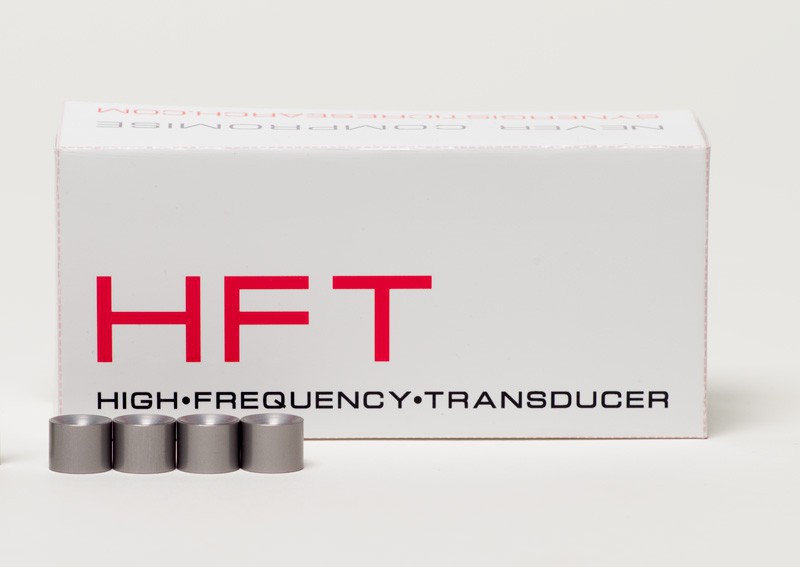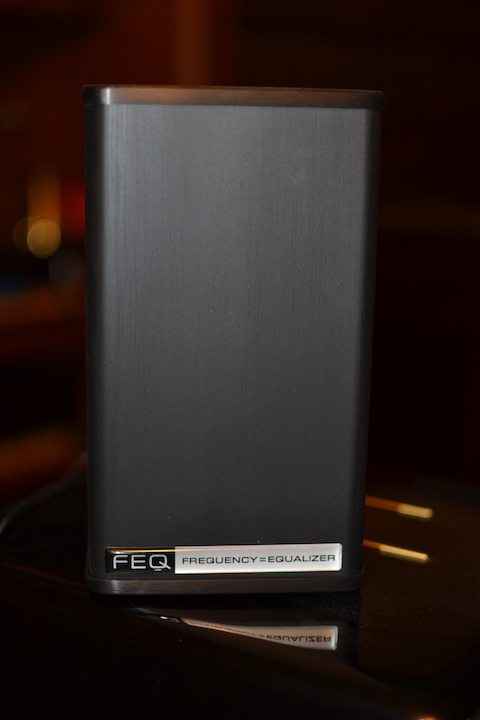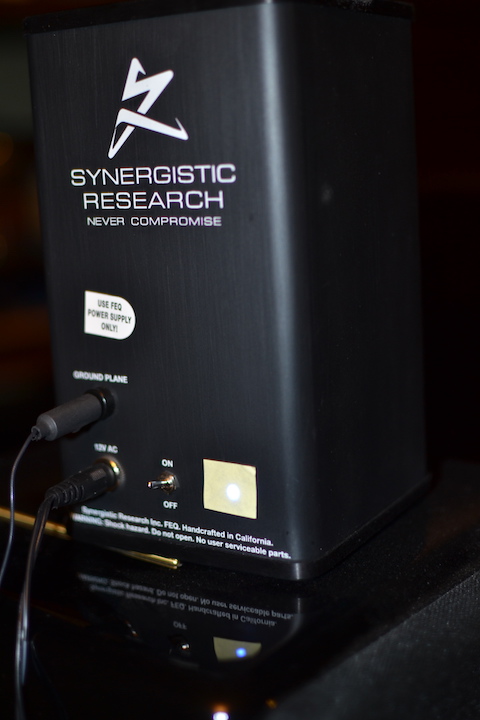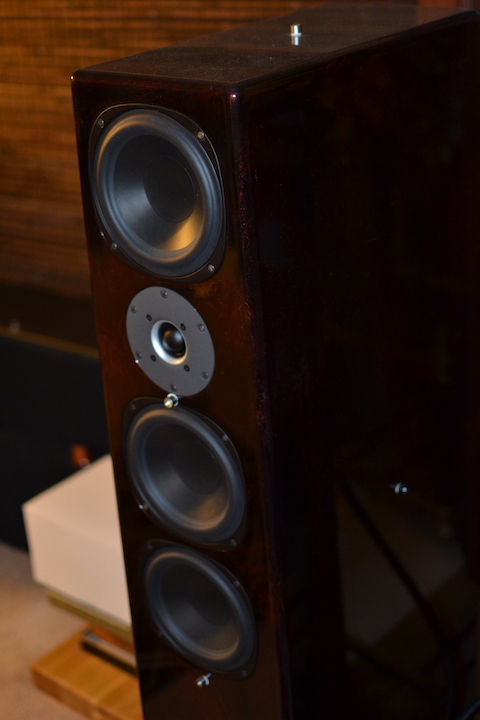Synergistic Research FEQ - Frequency Equalizer
Listed · 410 Views
This listing has ended.
Listings Similar to Synergistic Research
Time Left: Listing Sold
This listing has ended.
| Condition | |
| Payment methods | |
Contact seller after sale to pay via VISA/Mastercard or Wire Transfer | |
| Ships from | Los Angeles, CA, 90077 |
| Ships to | United States and Canada |
| Package dimensions | unspecified |
| Shipping carrier | UPS |
| Shipping cost | |
| Original accessories | Box |
| Research Pricing |
FLASH HOLLIDAY SALE :
FEQ - Frequency Equalizer small and powerful, like new from Synergistic Research dealer in factory boxes. Two available and sold EACH.
Can be used with or without Synergistic Research HFT wall dots (best to call David for details)
Highly recommended ...
See Positive Feedback review below:

https://positive-feedback.com/
Synergistic Research HFT and FEQ
06-28-2018 | By Malcolm J. Gomes | Issue 98 At the last Diana Krall live concert I attended, I happen to be seated next to an elderly woman who took great pleasure in singing, with all abandon, along with Ms. Krall for most of the concert. What made it worse was that she seemed to be quite tone deaf and sang totally out of tune resulting in a not very pleasant cacophony that stripped much of the pleasure that I could have otherwise derived from the concert. In typical Canadian fashion, I was much too polite to request her to refrain from singing along, preferring instead to suffer is stoic silence.
That experience reminded me of how the hundreds of surfaces in an audiophile's listening room react to the energy generated by our audio system. The surfaces of the furniture, walls, ceilings, racks, windows, fixtures, and even the speaker cabinets, are all excited by the sound generated by our speakers, and they respond by vibrating, thus generating sounds of their own. The problem is that, like the woman at the Diana Krall concert, they generate sound that is not in tune with the music from our speakers, thus resulting in an undesired distortion that diminishes the level of enjoyment that we derive from our music.
This undesired vibrations from the walls, ceiling, furniture, and fixtures in our listening room tends to restrict the sound stage mainly to the space between the two speakers. This happens because of compression of the air and decay restriction of the musical notes, which distorts the fundamental harmonics in the music and narrowing the sweet spot.
There is a good reason why, unbeknownst to many audiophiles, the listening room is one of the most important components of your audio system. Sadly, this component is often overlooked, or ignored, because many audiophiles are not cognizant of it or they simply regard it as a necessary evil that nothing much can be done about. So most audiophiles just throw in the towel. This is unfortunate, because in many cases, money put into improving listening room acoustics could deliver a better return on investment as compared to putting that same money towards upgrading your audio components.
Audiophiles who have done their due diligence on this matter put in a lot of effort to tweak their listening room to improve the sound quality that they hear from their systems. The conventional methods that they adopt are using corner bass traps, absorption panels at first reflection points, and diffusion panels behind the speakers and other strategic points in the listening room. The problem with absorption panels is that, if not done very carefully and judiciously, they can over-dampen the listening room and make it sound lifeless. It could result in musical notes not decaying realistically, and cause the air around the instruments that we perceive at a live performance, to disappear, literally, into thin air.
Over the past couple of decades, I went through the ubiquitous audiophile routine of periodically upgrading audio components until I finally arrived at a kit that, to my ears, sounds as good as anything I have heard, even when compared to many of the mega-buck system that I audition at various audiophile shows.
I then turned my attention to the acoustics of my dedicated listening room and tried to get that into the best shape that I possibly could. I got myself some custom-made corner bass traps, a few first reflection absorption panels and some diffuser panels. I then retained the services of an acoustician. He spent many hours in my listening room, painstakingly choosing the right spot to place all the panels, and fine-tuning my listening room so that it complemented, rather than fought, with the sound generated by my audio system. He had particularly good results with the wood diffusers that he placed behind my speakers, which enhanced the presence and texture of voices to a remarkable degree.
After having gone through this exercise, I could easily perceive a marked improvement in the quality of sound that my system generated in my listening room. The many audiophile visitors, who usually visit me on weekends for an audiophile listening session, also detected and commented on the positive differences that the acoustician made to my listening room.
Although I was pleased with the results, what kept nagging me was that I was cognizant of the fact that the walls, ceiling, furniture, and fixtures of my listening room were still vibrating disharmoniously with the music generated by my speakers. I was aware that even more improvement was there to be had, if only I could find a way to tame the adverse effects of this factor, on the sound I heard from my audio system. This thought gnawed at me. The acoustician I used acknowledged this problem, and he admitted that there was little that he, as an acoustician, could do about it. This was indeed a conundrum, and it prompted me to look elsewhere for solutions to tame the cacophony generated by the walls, ceilings, furniture, and fixtures of the listening room.
It was a truly frustrating exercise because my search made me realize that the market is full of charlatans peddling snake-oil products that claim to improve listening room acoustics. I tried many of them with little success. Then I happened upon the Synergistic Research HFT (High Frequency Transducers) range of products. When researching these, I read the claim that these HFTs clean up high-frequency harmonics in the listening room, and since harmonics are interconnected, when they affect harmonics higher than the human audible frequency spectrum, you also automatically affect the lower frequencies that are in the audible spectrum. Synergistic Research claim that their HFTs cancel harmonic noise on any surface on which they are placed, by replacing random out-of-tune resonances with a sympathetic resonance that complements the music.
This is quite a lofty claim to make, but it seemed something worth pursuing, so I bought myself a set of 10 HFTs and placed them in my listening room based on the guidelines provided by Synergistic Research. Given the tiny size of the HFTs, I was a bit skeptical and started the listening session with very low expectations. The HFTs did make a positive difference, which was a really pleasant surprise, especially after the frustration of being let down by all so many snake oil products that I went through in my quest.
This experience motivated me to explore this avenue further and so I got Dr. David Robinson, the Editor-in-Chief of Positive Feedback, to connect me to Andy Wiederspahn, the Operations Manager of Synergistic Research. I began a dialogue with Andy, and then met him in person at the TAVES 2017 Show. He encouraged me to try out of the full complement of HFTs together with the FEQ, which is a single channel ultra low frequency RF pulse generator that acts like a low frequency dither to overpower the ambient RFI and EMI fields in the listening room. Synergistic Research claims that the FEQ lowers the noise floor and natural uncompressed harmonics to improve the clarity of the music.
A few weeks after TAVES, Andy got me to send him photos of my listening room, after that he sent me a full complement of HFTs, HFT 2.0s and HFT-X along with the FEQ, complemented with diagrams as to where the HFTs and FEQ needed to be placed in my listening room. Getting all this gear installed, took less than half an hour, after which I sat down in the sweet spot for my first audition.
Right from the beginning of the audition, the positive difference in the sound quality was quite apparent. Two aspects of the sound that were plainly discernible were definition and focus. Musical notes were better defined, and instruments and voices on the sound stage, more focused.
I began the audition with Christopher Hardy's "Touch." With the HFTs and FEQ in place, the sound stage, especially the bells, were distinctively more expansive with more depth and width. With the lights off, sonically it did seem like my audition room was cavernous, way beyond its 27' by 18' dimensions.
Next up was "Viola Fora de Moda" by Ana Caram, from her Rio After Dark Album recorded by David Chesky. This track is very detailed and intricate, saturated with extremely subtle details. Usually I need a certain volume level to be able to hear all the subtleties, but now I was able to hear them at a lower volume level, which would indicate a significantly lower level of noise and grunge that would have masked these notes.
One of my favorite tracks for auditioning audio components is "The Dog Song," which is written and performed by Garett Brennan on the Blue Coast label. This is a very simple arrangement, so any distortion or discrepancies have no place to hide. On a good system, the sheer presence of Garett is unmistakable and with the HFTs and FEQ on duty, I could almost reach out and touch Garett as he deftly crooned out this tune.
One surprise that I did not expect was in the bass reproduction. When playing "Panther" by the legendary Marcus Miller, the bass was unmistakably deeper, but sadly not any more tuneful. I suspect that the Synergistic Research Black Box was designed to take care of this, and since a review of that component is in the cards, I will be able to confirm if it does work with the HFTs and the FEQ to make the bass not only deeper but also more tuneful.
I love to audition systems with tracks that have just one instrument played with a very simple arrangement. "Autumn Yearnings Fantasia," by Wei Li playing the guzheng, an ancient Chinese string instrument. This FIM production by the late Winston Ma, can be ultra revealing of a systems ability to reproduce attack and decay of musical notes. The HFT/FEQ combination did make their presence felt, reproducing the leading edges and decay of every note with more precision that I have ever heard before.
To test out the reproduction of female voices I utilized the track "Shepherds Moon" by Enya. Despite her very pronounced accent, I was able to decipher the lyrics with a lot more ease, thus reducing the fatigue factor. Her honey-toned voice was a lot more rounded, and had a lot more texture.
Even with complicated tracks like "Ida Y Vuets" by Gino D'Auri, where we have a multitude of instruments and very complicated arrangements, I was able to follow any instrument I chose, with a lot more ease.
I detected a more solid and stable soundstage when listening to "San Diego Stomp" by Bob James and Earl Klug from their Cool Album. This track has a very intricate arrangement and with the HFT/FEQ in place, it was rendered more deftly and with a lot more oomph.
I love every song sung by Simon and Garfunkel. Few duos synergize their voices as beautifully as these two singers. However, when listening to "Scarborough Fair," I was better able to appreciate the way those two voices complemented each other with the HFT/FEQ doing their thing.
Few audio systems are able to come even close to the live performance when reproducing large choirs rendering complicated arrangements. The "Hallelujah Chorus" sung by the Stockholm Bach Choir on the FIM Label, presents just such a challenge. I was pleasantly surprised to hear this choir sound like a collection of distinctively different but sublime voices complementing each other, rather than an amalgamation of voices, which was the case before I added the HFT/FEQ combination to the mix.
When listening to the track "Keith Don't Go" by Nils Lofgren, it is hard to imagine that such full and majestic sound can be achieved by just one man and his guitar performing live on stage. Synergistic Research's little marvels enhanced even this listening experience by allowing the leading edges of Lofgren's guitar strums come through with better definition and weight.
The sound of a well-crafted violin, like a Stradivarius, can be quite a challenge to reproduce accurately. So I put on the track "Allegro Andante Sostenuto" with the maestro David Oistrakh on violin and the London Symphony Orchestra, produced by FIM. I was pleased to hear the violin sound very smooth and velvety with the distinctive woody tone that makes this instrument so pleasurable to hear.
Percussion was also rendered more accurately, as was evidenced when I put on "L'Daddy" on James Newton Howard & Friends album, from Sheffield Lab label. I could hear the crisp kettle and kick drum strokes with a level of impact that I could feel in my bones.
One of the most complicated instruments to reproduce is the piano. I used to play the piano professionally, and I usually indulge in a 10-minute session on my acoustic piano before auditioning any audio gear so as to refresh my mental reference of what a live performance on a piano sounds like. What I look for in the reproduction are piano notes that have just the right weight, are well rounded, and where it is easy to perceive that the sound is made with felt lined hammers hitting strings. I listen carefully for the "clear-as-a-bell" like quality to the higher notes, and the accurate menacing growl on chords involving the bottom octave notes that are played aggressively. I played "A Time for Love" by Melissa Walker on the Burmester CD-3 album. I could tell that the reproduction of piano notes was quite exquisite, very organic, and with just the right weight, harmonic complexity, attack, and delay that make it such a versatile musical instrument.
I do most of my listening late in the evening and well into night. What I discovered is that the HFTs and FEQ combo can really strut their stuff after midnight when the demands on the grid are at a minimum, and the power supply is a bit cleaner. During these hours, the music with the HFTs and FEQ sounded truly sublime.
Synergistic Research HFTs are placed on the walls and ceilings of the listening room as well as on your speaker cabinets. Hitherto, you had access to only one type of HFT per box, and it takes three types of HFTs to optimize the sound of your speakers. In a good marketing move, Synergistic Research now offers a special pack with exactly the type and number of HFTs that you need for a pair of speakers. This makes it easier and much more cost effective for audiophiles who want to minimize the unwanted resonances from their speaker cabinets.
I like to think of the audiophile listening experience in terms of the music being the paint, your audio system being the painter, and your listening room being the canvas. You can get the best quality paint and a very skilled painter, but if the canvas is not pristine, it will distort the painting. The HFT/FEQ combination serves to make your listening room canvas more pristine so that when your audio system paints the music on it, the end result is a lot more true to life.
Needless to say, the Synergistic Research HFT/FEQ combination I used in this review is not going anywhere. They are now an integral part of my reference audio system.
Synergistic Research HFT
Retail: $299 a set of 3
Synergistic Research FEQ
Retail: Starting at $995
Synergistic Research
949.476.0000
================================================================
We are the #1 Estate Audio Specialist in California and a "full service" best option (buying outright Estates or consigned selling for you), Audio Gear including whole Estate & Purchases.
We are a Factory direct Authorized dealer for Bowers & Wilkins, Synergistic Research, Aqua Acoustics, Bryston, REL, Project, EAR, and many of the finest products covering all needs and budgets
Please contact us if you have or know of an estate of audio gear that needs help selling and or helping you manage the purchasing or if you just have questions. We have a long history and are full service experts we will strive to make it easier for you. Give us a call and ask for David Weinhart and we can help you get the best possible outcome.
* * * We are always interested in purchasing quality Audio items, LP collections and quality trades are welcomed. * * *
Please call David Weinhart to help you make the best sound possible and available weekdays from 11-4PM @ 310-472-8880 or on my cell text or call seven days a week including weekends from 10-7PM at 310-927-2260
Weinhart Design has lots of other items new and used and if you’re in Los Angeles or visiting please accept my invitation to experience our Audio Showroom by appointment and please visit our web site www.weinhartdesign.com
We are a top Bel Air based full service, Store that offers, Sales, Design, Lighting & phone control, Repair, in home Service, Installation, Wi Fi, and Automation,
All sales out of California are State Sales Tax exempt.
All sales in California State Sales we add California State Sales Tax 9.5% and it apply s applies for items picked up or shipped to a California address.
We accept payments by Bank Wire Transfers without fees on sales over $1,000 and is the only form of payment on all sales out of the U.S. and Canada. We prefer this method of payment on sales out of the USA & Canada and also makes shipping to addresses other than billing OK.
VISA, MC and Papal are gladly accepted within the U.S. and Canada as long as the charge is approved and were shipping to the BILLING ADDRESS and shipping to the billing address on record and adds a 3% fee to cover costs. We also accept AMEX & Discovery cards at the cost of 4%.
We accept Bank Checks without fees and do have some other no fee options (best to call David Weinhart the founder / owner for other no fee options and to consider any trades).
AMEX & Discover are also available for a 4% cost if shipped to the Billing Address and approved.
Please note: All credit card and PayPal transactions are subject to a 3% processing fee and to pay either give us a PayPal address or call to charge VISA or MC (3% cost added) and / or we can provide other payment options best to call or Text David Weinhart in Los Angeles any time from 10am - 7pm at: 310-927-2260. Also we have some non fee options like Bank Checks and Bank Wire transfers.
Please call me directly in my world class showroom in Los Angeles weekdays:
from 11-4PM @ 310-472-8880 or on my cell including weekends from 10-7PM at 310-927-2260 and I can answer your questions and help you with all of your design, new and preowned needs.
Making better Sound
One system at at a time,
David Weinhart
Weinhart Design, Inc.
President & CEO
The Audio and Video Expert
e: [email protected]
www.weinhartdesign.com
2337 Roscomare Road, Studio #1
Los Angeles, California 90077
Showroom: 310-472-8880
Cell: 310-927-2260 PST seven days text or call from 10am - 7pm
No questions have been asked about this item.
Ask the seller a public question
You must log in to ask a question.
Return Policy
Return Window
Returns are not accepted on this item.






